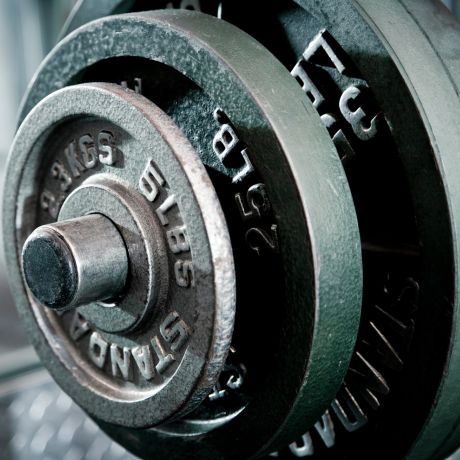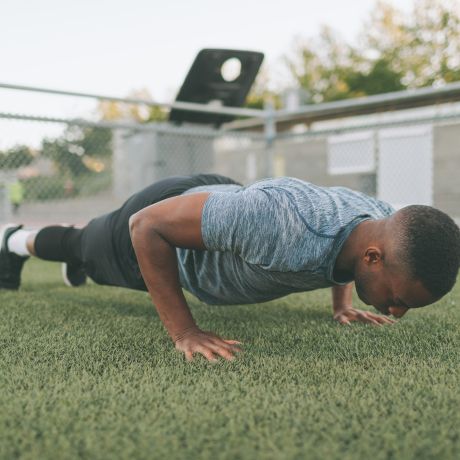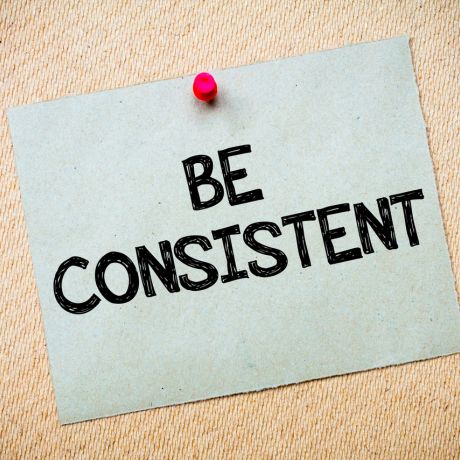Deciding that you need to get stronger is exciting! Nevertheless, it might probably be hard to know should you’re actually making progress should you do not know where to start out.
For individuals who do not know where to start out in relation to strength training, you might have to create a place to begin often called a strength baseline. Consider it as the muse for constructing your strength and muscular endurance.
On this in-depth guide, I’ll break down the importance of getting a baseline, tips on how to establish it, and the essential tests I like to recommend to find out your place to begin accurately.
Table of Contents
- What’s a Baseline?
- How one can Establish a Strength Baseline
- How To Increase Your Overall Strength Baseline
- Outro
What’s a Baseline?
The short answer is that a baseline is your place to begin. In terms of strength training, a baseline refers to your initial level of strength and muscular endurance before you begin a training program.
It also gives you a snapshot of your current physical capabilities, serving as a reference point from which you possibly can accurately and quickly gauge your progress over time. A few of the most vital reasons for establishing a baseline are:
Personalization: It lets you higher tailor your training program to your needs and skills.
Goal Setting: It lets you set more realistic and achievable goals based in your place to begin.
Progress Tracking: It’s also a benchmark for measuring your progress and identifying areas needing improvement.

How one can Establish a Strength Baseline
Making a strength baseline normally requires you to conduct specific tests and assessments to guage various features of strength, endurance, and even your body composition, depending on whether you ever plan to compete.
Here’s a step-by-step guide on how I test my clients as a private trainer to determine their strength baseline effectively:
Strength Baseline Tests:
One-Rep Max (1RM) Test:
One of the vital common ways to measure absolute strength is the one-rep max test. It helps to evaluate the utmost weight a person can lift for a single repetition with proper form. Here’s how I like to recommend people to conduct the 1RM test:
- Select a compound movement corresponding to squat, bench press, or deadlift.
- This may increasingly seem obvious, but I at all times recommend that you just perform a general warm-up to extend blood flow, reduce the chance of injury, and prepare your muscles for the upcoming lift.
- Arrange for the compound lift, start with the bar, and steadily increase the load. I like to recommend only performing 5-8 repetitions with lighter weights to maintain yourself from exhausting the muscles but still effectively warming up.
- Increase the load until you might have a difficult load on the barbell, and attempt a single repetition with proper form. If you happen to are successful, increase the load and repeat doing one rep until you get to a weight that induces failure.
-
Note the utmost weight lifted as your 1RM for the chosen exercise in a weight-lifting journal or in your phone, or use our Downloadable Strength Baseline PDF available further down.
Five-Rep Max (5RM) Test:
The five-rep max test helps you get incredible insight into your strength endurance and is barely less taxing than the 1RM test. I like to recommend that folks do that test if they are not confident of their one-rep testing or are terrified of getting hurt under heavy weights.
Follow these steps to finish the 5RM test:
- Select a compound movement much like the 1RM test.
- Perform an intensive warm-up to organize your muscles for the upcoming lift. I do not recommend doing a couple of RM test per workout, as the chance of injury could be incredibly high.
- Steadily increase the load in each warm-up set; I like to recommend completing around 3-5 repetitions with moderate weights.
- Load the barbell with a weight you suspect you possibly can lift for five consecutive repetitions with proper form. All the time be sure that to have a spotter available just in case you fail.
- Perform five repetitions with the chosen weight, using the right technique for every rep. Increase the load should you feel you possibly can achieve this.
- Record the utmost weight lifted for five reps accomplished as your 5RM for the chosen exercise.

Muscular Endurance Test:
Muscular endurance is crucial for constructing strength and improving sustained physical activity. Testing endurance typically requires lighter loads, like your body weight, and is completed for longer periods.
By increasing endurance, you’ll improve cardiovascular fitness, athletic development, mental willpower, and the way long your muscles can work under load.
Two of essentially the most common tests are the push-up or pull-up tests, each easy yet effective ways to evaluate upper-body muscular endurance. Here’s tips on how to conduct the push-up test:
- Start in a plank position together with your hands shoulder-width apart and elbows fully prolonged.
- Lower your body until your chest touches the ground, then beat back to the starting position.
- Perform as many push-ups as possible while keeping good form (keeping a straight line from head to heels).
- Write down the variety of reps you accomplished before hitting failure as your rating for the push-up test.

Mobility Test:
While it could not seem essential in relation to strength, mobility assessments are crucial for evaluating your range of motion and functional movement patterns. Having a mobility baseline can higher discover any restrictions or limitations in your joints and muscles affecting your performance and increasing the chance of injury.
Listed below are two of the mobility tests I mostly do with clients:
Squat Depth Test:
The squat depth test helps assess your ability to perform a deep squat properly. It also evaluates the flexibleness and mobility of your hips, knees, and ankles.
It’s best performed before a leg workout to find out whether it’s best to proceed; should you don’t do well, you might want to think about working on more mobility exercises.
- Stand together with your feet shoulder-width apart and squat down as little as possible while keeping your heels on the bottom and your chest up.
- Aim to lower your hips until you might be below parallel to the bottom.
- A passing rating could be achieving a deep squat position without significant discomfort or compensations in your squat form.

Shoulder Mobility Test:
This shoulder mobility test, also often called the scratch test, focuses on testing the range of motion in your shoulders and upper back. It’ll assess your ability to succeed in overhead and behind your back without causing pain or having any restrictions.
- Lift your right arm directly above your head.
- Bend your right elbow and place your right palm on the back of your neck, together with your fingers pointing downward.
- Together with your left hand, reach behind your back and rest the back of your hand against your spine, palm facing away out of your body.
- Gently slide your right hand down the back of your neck and your left hand up your spine, bringing them closer together.
- Once you’ve got reached your maximum reach, the examiner will measure the space between your fingers.
- Release the stretch by reversing the movement and returning to the initial position.
How one can Use A Mobility Baseline As Part Of Your Training Program
- If you happen to can do the mobility test without issues or having to compensate (green light), then it’s best to proceed with the planned training. If red light, perform corrective drills.
- Re-evaluate baseline performance by completing the test again.
- If a green light, proceed with the planned training. If a red light, incorporate additional drills.
- Review baseline performance once more.
- If it still indicates a red light, I like to recommend implementing regression exercises or taking a rest day.
- Reassess the baseline in the course of the next training session and adjust accordingly.

Body Composition Test:
While not completely needed for making a strength baseline, should you plan on ever competing (like powerlifting or bodybuilding), understanding your body composition will make optimizing your fitness program, overall health, and nutrition easier.
A body composition evaluation provides helpful insight into how the fat and muscle in your body are distributed, in addition to if it is advisable drop a few pounds or gain muscle. Listed below are two of essentially the most common methods for body composition evaluation:
Skinfold Measurements:
Skinfold measurements are certainly one of the best ways to check body composition because it involves using calipers to measure the thickness of skinfolds at specific spots on the body. I’d recommend talking to a trained skilled who knows what they’re doing to get essentially the most accurate results.
They are going to use calipers to pinch and measure skinfold thickness at sites corresponding to the triceps, abdomen, and thigh. These measurements are then plugged right into a formula to calculate body fat percentage.
Bioelectrical Impedance Evaluation (BIA):
BIA measures the body’s resistance to electrical currents to estimate body composition. It’s in a position to do that by sending a low-level electrical current through the body and measuring the way it travels through various kinds of body tissue.
There are multiple options, essentially the most common being a scale with electrodes you stand on or holding a handheld device with electrodes.

How To Increase Your Overall Strength Baseline
Once you’ve got been able to determine your baseline, the true work begins toward improving and surpassing your current limits. To be sure that that you just are increasing your strength baseline effectively, I’d recommend that you just use these strategies:
Progressive Overload:
Progressive overload is probably the most essential principles in relation to strength training. It involves steadily increasing the demands in your muscles over time to stimulate growth and adaptation higher.
Listed below are a few the ways I like to recommend to use progressive overload to your strength program:
- Increase Intensity: To get essentially the most out of your workouts, be sure that you are difficult yourself by slowly increasing the weights you lift during exercises. This can be sure that you are keeping your muscles under tension.
- Adjust Volume: One among the things I notice people never do is that they do not steadily increase the variety of sets and repetitions performed for every exercise. As a substitute, they do the identical sets and reps every week. Change things up, and it will be easier to induce muscle fatigue and promote growth.
- Vary Frequency: Experiment together with your training frequency; should you are recovering appropriately, try incorporating additional workout sessions or training splits to offer your body adequate stimulus for muscle and strength development.
- Follow a Program: One among the best ways to construct strength without considering an excessive amount of or worrying that you just are doing the whole lot right is to follow a strength program. This 13-week training plan from certainly one of our head coaches is an incredible option and can make it easier to get the outcomes you desire.
By consistently pushing your limits and progressively increasing the demands in your muscles, you may begin to see serious strength and muscle gains toward your fitness goals.

Proper Nutrition:
Nutrition plays a very important role, if not an important because good nutrition helps support muscle repair, growth, and overall performance. To completely optimize your strength gains, I at all times recommend that my clients deal with the next dietary aspects:
- Proper Caloric Intake: Typically, to see significant increases in strength and muscle gain, it is advisable devour enough calories to satisfy your body’s energy needs, especially during intense training. Having a slight caloric surplus could make seeing these sorts of results manageable and achievable.
- Macronutrient Balance: In fact, your food plan is not only as easy as calories in vs calories out; it is advisable be sure that your food plan provides adequate protein, carbohydrates, and healthy fats to fuel workouts, facilitate recovery, and promote muscle protein synthesis.
- Hydration: If you happen to do not stay adequately hydrated, you run the chance of getting decreased exercise performance, cramps, and worse recovery. The really helpful total every day fluid intake based on research is 3,000 ml for men and a pair of,200 ml for girls, which needs to be greater than adequate.¹
I at all times tell my clients that 60-70 percent of achieving their goals comes from having proper nutrition and hydration. So, by fueling your body with the suitable nutrients at the right times, you may provide your body with the muse for prime strength development and recovery.

Adequate Rest and Recovery:
Outside of nutrition, rest and recovery are incredibly essential parts of any effective strength training program. If you happen to fail to deal with sufficient time for recovery, it might probably result in overtraining, fatigue, increased risk of injury, and impaired performance.
Listed below are some suggestions I exploit and recommend to prioritize rest and recovery:
Quality Sleep: Research shows that getting 7-9 hours of quality sleep per night is best for optimal health advantages, especially in relation to facilitating muscle repair, hormone regulation, and overall recovery.²
Energetic Recovery: Occasionally, on days that you just take off from the gym, I like to recommend incorporating light activity, stretching, foam rolling, or yoga sessions to extend blood flow, reduce muscle soreness, and keep recovery going.
Rest Days: Sometimes, you possibly can’t help it, and you will have to schedule one or two rest days into your training program to permit your muscles and central nervous system to get well entirely from intense workouts.
I see too many individuals focusing an excessive amount of on their training and never enough on their rest and recovery. By prioritizing rest and recovery, you may optimize the difference process, reduce the chance of injury, and even aid you in making sustainable progress in your strength journey.

Consistency:
While you possibly can see some success quickly, consistency is the important thing to long-term, significant success in strength training. Establishing and sticking with a consistent training routine is vital for achieving and surpassing your strength baseline.
To avoid overcomplicating and giving up in your plans, listed below are a few of the most effective ways I do know tips on how to maintain consistency:
Set Realistic Goals: While I can understand the dream of bench pressing 1000 kilos, I like to recommend establishing clear, more achievable goals to maintain you motivated and direct your training efforts.
Develop a Routine: Day-to-day life could be chaotic, making getting within the gym consistently tricky. By making a structured every day routine and scheduling your workout sessions upfront, you make it easier for yourself to remain consistent and more likely to achieve achieving your strength goals.
Stay Motivated: Essentially the most significant factor in relation to staying consistent is to search out sources of inspiration and motivation to maintain you focused and committed to your training journey, whether it’s through personal achievements, supportive communities on social media, and even skilled guidance by a coach.
I at all times tell those who by staying consistent with their training and lifestyle habits, they’ll construct momentum, develop higher discipline, and ultimately improve upon their initial strength baseline. So pace yourself, and do not attempt to rush the method; you will get there in time.
Outro
Despite what it could appear, figuring out is more about training smarter, not harder. So, establishing a solid strength baseline is a very important step, no matter where you might be at in your fitness journey, since it provides helpful insights into your current level of strength and muscular endurance.
Armed with the knowledge from this text, it’s best to have the option to set more realistic goals, track your progress more effectively, keep injuries at bay, and tailor your training program to maximise results.
References






